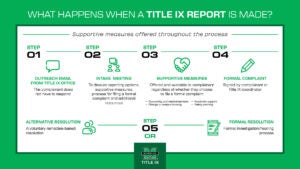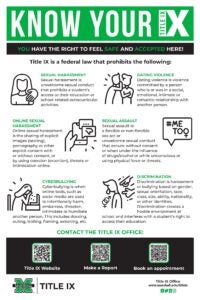Explore the Title IX Process
The Title IX Office conducts prompt, fair, and impartial investigations of sexual misconduct, Title IX sexual harassment, other gender/sex based discrimination, allegations of pregnancy and pregnancy related condition discrimination experienced by students, that avoid pre-judgement of facts at issue, conflicts of interest, and bias. The presumption is that no policy violation has occurred unless proven otherwise by a preponderance of the evidence in an adjudication process.
What are the steps in the Title IX Process?
When the Title IX Office receives a report, the Title IX Coordinator will make an assessment and respond to any immediate health or safety concerns raised in the report. The initial assessment includes:
- Assess the Complainant’s safety and well-being, and offer supportive measures and assistance;
- Inform Complainant of the right to seek medical treatment and explain the importance of obtaining and preserving forensic and other evidence;
- Inform Complainant of the right to contact law enforcement, decline to contact law enforcement, and/or seek a protective order;
- Inform Complainant about University and community resources, the right to seek appropriate and available supportive measures, and how to request those;
- Inform Complainant of the right to seek Informal Resolution (when available) or Formal Resolution; ascertain Complainant’s expressed preference on how they want to proceed; and discuss any concerns or barriers to participating in investigation and resolution;
- Explain the prohibition against retaliation and that prompt action will be taken in response to any act of retaliation;
- Access the nature and circumstances of the report, including whether it provides names and/or any other information that personally identifies the Complainant, Respondent, any witness, and/or any other third party with knowledge of the incident;
- Ascertain the ages of Complainant and Respondent, if known, and if either party is a minor, contact the appropriate child protective service agency; and
- Communicate with MUPD and other appropriate Marshall officials to determine whether the report triggers Clery obligations.
What are the different options for resolution?
If the allegations forming the basis of the Formal Title IX Complaint would not, if substantiated, constitute Title IX Sexual Harassment or Retaliation, the Title IX Coordinator shall dismiss the Formal Title IX Complaint from the Formal Resolution Process (“Mandatory Dismissal”).
- Mandatory Dismissal: If the conduct alleged in the formal complaint (a) would not constitute sexual harassment as defined in Policy GA-1 even if proven, (b) did not occur in the University’s education program or activity, or (c) did not occur against a person in the United States, then the University’s Title IX Coordinator must dismiss the formal complaint with regard to that conduct for the purposes of sexual harassment under Title IX, or this part; such dismissal does not preclude action under another provision of the Student Code of Conduct. The Title IX Coordinator may also discretionarily dismiss complaints in certain circumstances (“Discretionary Dismissal”).
- Discretionary Dismissal: The Title IX Coordinator may dismiss the formal complaint or any allegations therein if, at any time during the investigation or hearing; (a) a complainant notifies the Title IX Coordinator in writing that the Complainant would like to withdraw the formal complaint or any allegations therein; (b) the Respondent is no longer enrolled or employed by the University; or (c) specific circumstances prevent the University from gathering evidence sufficient to reach a determination as to the formal complaint or allegations therein.
The Title IX Complainant (“Complainant”) and the Title IX Respondent (“Respondent”) may request a review of the dismissal, as described in the procedures. The Title IX Coordinator may also refer the matter to other departments.
An informal resolution is an alternative to a formal investigation in which both sides voluntarily agree to “informally” resolve issues or concerns involving harassment, discrimination, or retaliation.
- If either party wishes to pursue an informal resolution, they can at any time before a determination in the matter.
- Parties have to agree to an informal resolution. If only one party agrees, the formal resolution process will continue.
- If the parties agree to an informal resolution, the Title IX Office will work with the parties to determine the terms of the resolution.
- The resolution’s terms will be written, and all parties must sign the document.
The Title IX Office remains available for support/questions/resources for the parties, regardless of the outcome.
A formal resolution involves conducting an investigation and possibly a hearing to determine responsibility for the alleged sexual misconduct. The steps include:
- Formal Complaint Filed
- Notice of Investigation Issued: All parties are notified, and an Investigator is assigned.
- Information Gathering: Parties may provide information through interviews, written statements, witnesses, and other evidence.
- Draft Investigation Report: The Investigator creates a Draft Investigation Report and provides it to the parties for response and reply.
- Final Investigation Report: Written responses, replies, and additional evidence are added to the Final Investigation Report.
- Distribution of Final Report: The Investigator supplies the Final Investigation Report to the Title IX Coordinator for distribution to the parties.
- Response to Final Report: Parties can file a response to the Final Investigation Report.
- Review by Title IX Coordinator: The Title IX Coordinator reviews the Final Investigation Report and any responses to determine if the investigation reveals facts requiring or permitting dismissal or if the matter should be referred for a hearing. Parties can appeal the dismissal.
- Conclusion or Hearing: The matter concludes if dismissal is neither appealed nor upheld. If referred for a hearing, a pre-hearing conference and a hearing will be held.
- Hearing: The Review Panel decides if it is more likely than not that the Respondent violated the Policy. If a violation if found, sanctions may be issued. Panel decisions are made by majority vote.
- Appeal: Parties may appeal the Review Panel’s decision based on allowed procedures.
- Final Decision: An Appeal Officer reviews the appeal and any responses before issuing a final decision.
The Title IX Office remains available for support, questions, and resources for all parties, regardless of the outcome.
Anonymous Reports or Desire Not to Pursue Investigation/Disciplinary Action
 While we do what we can to ensure confidentiality, due to certain rights and responsibilities, we may not be able to honor these types of requests for the following reasons:
While we do what we can to ensure confidentiality, due to certain rights and responsibilities, we may not be able to honor these types of requests for the following reasons:
- There can be no anonymity if punitive actions are taken against Respondent.
- Confidentiality is an aspiration but is not always possible or appropriate.
- Marshall may be limited in its response and investigation if confidentiality is requested.
- When Complainant requests no investigation, Marshall has to balance the request for privacy with the institutional responsibility of ensuring a safe educational environment and workplace.
- If possible, a report may be pursued without Complainant’s participation in the investigation or resolution. A review will be made to determine if there are security camera recordings, corroborating reports from other witnesses, physical evidence, or any evidence showing Respondent made statements of admission or otherwise accepted responsibility for the prohibited conduct.
The Title IX Office remains available for support/questions/resources for the parties regardless of Complainant not wanting to proceed.
If you have any questions or would like additional clarification regarding the Title IX process, please review the Title IX Procedures or contact the Title IX Coordinator.
Under Title IX, only a narrow category of cases falls under Title IX. Those cases meeting the definitions and jurisdictional elements below will follow the Marshall procedures below:
Marshall Title IX Procedures for StudentsMarshall Title IX Procedures for Employees
Those cases involving students that do not fit within the narrow category set by Title IX will follow the Marshall procedures below:
Marshall Non-Title IX Procedures for Students


